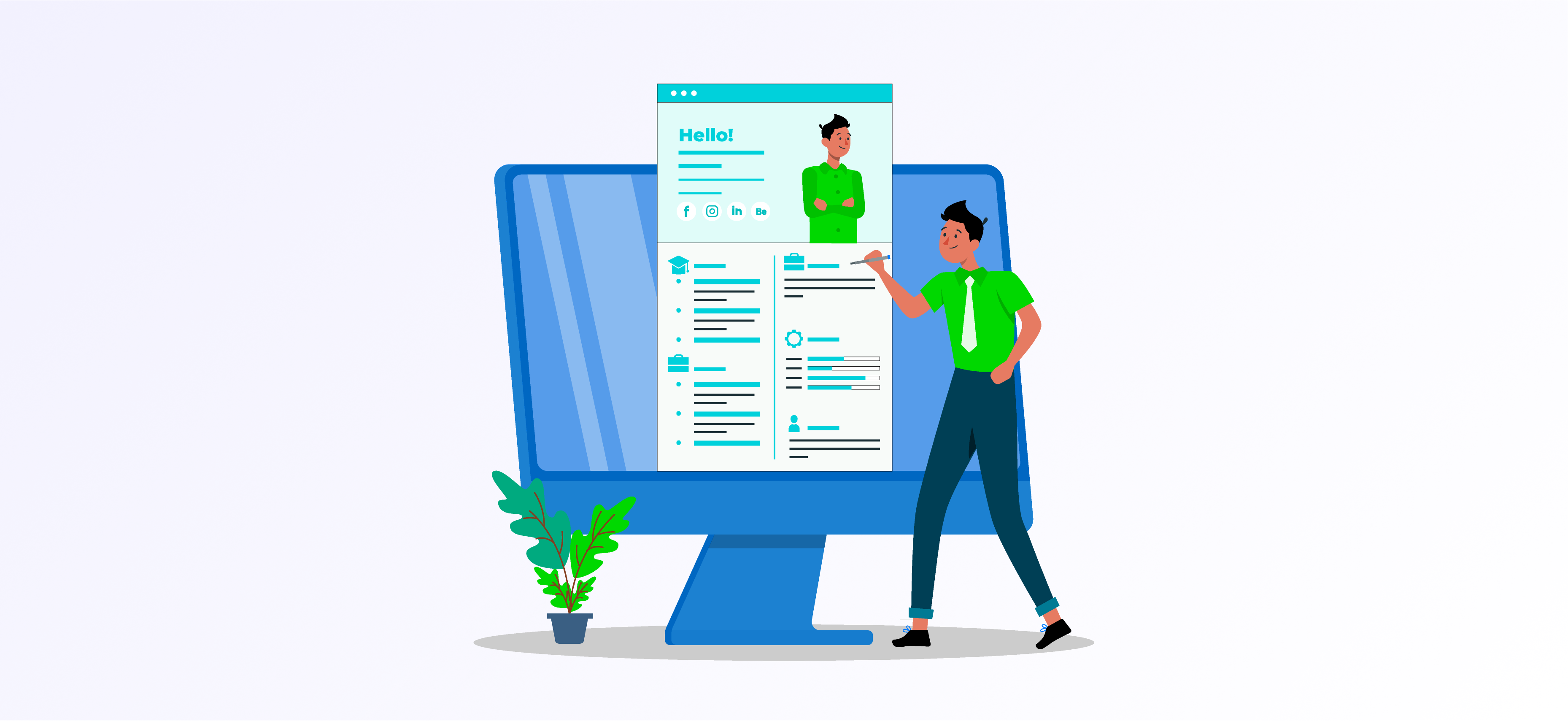Your resume is your golden ticket to achieving your dream job. But just like you wouldn't wear sneakers to a fancy event, your resume format should match your profession. Did you know that tailoring your resume can increase your chances of getting noticed by 65%, according to an article on LinkedIn?
Another article claims that nearly 80% of recruiters and hiring managers spend 7.8 seconds reviewing a resume. Whether you're an artist, engineer, marketer, or in any other field, we've got you covered. In this blog post, we'll dive deep into the world of resume formatting for various industries.
In this blog:
- The Foundation of a Professional Resume Format
- Fine-Tuning a Resume for Specific Careers
- Incorporating Design ElementsAdditional Resources & Tools
- Final Thoughts
The Foundation of a Professional Resume Format
A professional resume is crucial for presenting your qualifications, skills, and experiences to potential employers. It is a snapshot of your professional background and is typically the first impression you make on recruiters or hiring managers. The foundation of a professional resume format consists of several key elements that work together to showcase your candidacy effectively. Here are the essential elements to include in your resume:
Contact Information:
At the beginning of your resume, include your full name, active phone number, professional email address, and physical location. Additionally, consider adding your LinkedIn profile or a personal website/portfolio if they are relevant and well-maintained.
Professional Summary:
Craft a compelling professional summary highlighting your skills and goals and incorporating a unique value proposition. This is your chance to grab the reader's attention by showcasing your expertise in a way that aligns with the company's needs.
Work Experience:
Along with your job titles, company names, and employment dates, emphasize quantifiable achievements that showcase your impact in previous roles. Incorporate numbers, percentages, or specific outcomes to clearly show your contributions. Consider integrating a short anecdote or accomplishment that demonstrates your adaptability or problem-solving skills to add a unique touch.
Education:
While listing your degrees, institutions, and graduation dates, include any relevant coursework or projects that set you apart from other candidates. If you've pursued additional online courses, workshops, or certifications that are directly related to the job, mention them here.
Skills:
Go beyond a simple list of skills by categorizing them based on proficiency levels. This gives employers a clearer understanding of your capabilities. Incorporate a mix of technical skills, such as programming languages, software tools, etc., and unique skills like cross-functional collaboration or creative problem-solving.
Unique Elements:
Languages: If you are proficient in languages other than your native tongue, highlight them. Fluency in additional languages can be valuable, especially in global or customer-facing roles.
Publications or Presentations: If you've authored articles, research papers, or given presentations at conferences, include a section showcasing your intellectual contributions.
Volunteer Work: Volunteering for causes relevant to the job or industry can demonstrate your commitment and alignment with the company's values.
Side Projects or Hobbies: Include any side projects, hobbies, or creative pursuits that showcase skills or qualities that align with the job. For example, if you're applying for a marketing role, your personal blog could be relevant.
Testimonials or Recommendations: Consider adding brief quotes or recommendations from colleagues, supervisors, or clients to provide social proof of your abilities.
Remember, the goal is to present a holistic view of yourself as a candidate. Including unique elements demonstrating your personality, adaptability, and alignment with the company culture can make your resume stand out and leave a great impression.
Fine-Tuning a Resume for Specific Careers
When you're applying for a job, think of your resume as a key that unlocks the door to your next opportunity. Like how you'd use the correct key for a specific entry, fine-tuning your resume is like choosing the right details to showcase. It's important because it helps the company see that you have what they need. By customizing your resume to match the job's requirements, you're making it easier for them to see how well you fit in. This extra effort can make a big difference in catching the employer's attention and increasing your chances of getting the job. It's all about ensuring your resume speaks the same language as your desired job. Here are some tips on how you can do so:
Strategically Analyze Job Descriptions:
To refine your resume, immerse yourself in the job descriptions of the roles that interest you. Please take a good look at what they're asking for. This helps you uncover the keywords and skills they value the most. It's like learning their language. Once you know what they're looking for, you can adjust your resume to highlight those skills and experiences. This way, your resume speaks directly to what they want. It's an intelligent way to make your application stand out because it shows you're a great match for what they need.
Tailor Your Professional Summary and Highlight Relevant Experience:
Your professional summary is like the introduction to your resume. It's the first thing people read. Here, you talk about your primary skills, the things you've done, and what you want to do. When changing your resume for a certain job, ensure your professional summary shows the skills they're looking for. This way, they see that you have what they want right away. Also, talk about experiences that match the job. If you did something similar before, say it. This shows you can do well in this new job too. And if you did things they asked for, that's even better. It's like showing them you already know how to do what they need.
Crafting a Focused Skills Section:
The skills section is a short way to show what you're good at. When you're making your resume fit a certain job, change this part to include the words they use in the job description. This helps them see that you have the skills they want. By doing this, you're showing that you're a good match for what they're looking for a job.
Incorporate Industry-Specific Keywords and Jargon:
Adding industry-specific words and phrases to your resume is a smart move. Using the same words that people in that field use helps you connect better with them. This shows recruiters that you know what you're talking about and proves that you're familiar with how things work in that industry. It's like speaking their language and letting them know you're on the same page.
Highlight Transferable Skills and Relevant Certifications:
Career transitions necessitate the spotlighting of transferable skills. These versatile competencies demonstrate your adaptability and readiness for new challenges. Additionally, certifications that directly support your qualifications for the job serve as compelling endorsements of your expertise. Including these subtly underscores your commitment to continuous growth and development.
Tailor Accomplishments and Consider Industry-Specific Sections:
The part of your resume where you talk about your achievements is crucial. This is where you prove what you've done by giving specific examples. You can use the STAR method, which means you talk about the situation, what you need to do, the steps you took, and the results you got. It's like telling a story about how you made things better. Also, when changing your resume for a specific job, please focus on the achievements that match what they're looking for. If you've written articles or been to conferences related to the job, it's good to mention them too. This shows you really understand the job and are already involved in it.
Incorporating Design Elements
Incorporating design elements into a resume is crucial because it enhances the document's visual appeal, readability, and overall impact. Effective design choices help organize information, guide the reader's attention to key details, and create a professional and polished presentation. Well-designed resumes are more engaging and memorable, making it easier for employers to quickly grasp your qualifications and potential. Here are some crucial points to keep in mind.
Typography and Text Styling:
Incorporating professional typography is essential. While we have already discussed the importance of choosing the right typography, we wanted to delve further into the topic. Choose clear, readable fonts that suit the resume's tone. Use appropriate font sizes for headings and content to establish a hierarchy. Employ text styling elements such as bold or italics to emphasize essential details like job titles or key skills.
Visual Elements:
A limited color palette can enhance the visual appeal of your resume. Carefully select colors that align with your personal brand or industry. Use these colors for headings, accents, and dividers to create a consistent and visually pleasing layout. To further engage the reader, consider integrating relevant icons sparingly. These icons can represent skills, languages, or other relevant information.
Layout and Organization:
Organize your resume effectively by clearly distinguishing different sections. You can achieve this by incorporating lines, icons, or dividers that visually separate each section. A two-column layout is a practical choice, allowing you to present information efficiently while optimizing space. White space, or the empty areas around content, contributes to a clean and spacious design. Additionally, bullet points help break down achievements and skills, making them easier to read and comprehend.
Consistency and Proofreading:
Maintaining consistent formatting throughout your resume conveys a professional image. Ensure that fonts, font sizes, and other formatting elements remain uniform. To create a strong impression, carefully proofread your resume to eliminate errors. A polished resume looks appealing and showcases your attention to detail and commitment to quality.
Additional Elements:
Including subtle links to your LinkedIn profile or portfolio can give recruiters additional context about your professional background. Utilize white space strategically to create separation between sections, making it simpler for readers to navigate through your resume.
Additional Resources & Tools for Resume Building
Creating a compelling resume is essential for making a solid first impression on potential employers. To assist you in this process, various resources and tools offer innovative ways to enhance your resume's effectiveness. One such tool is CareerAI, a cutting-edge platform designed to optimize your resume-building experience.
CareerAI: CareerAI stands out as an exceptional tool for crafting impactful resumes. This platform employs advanced AI technology to provide personalized guidance based on your career goals and qualifications. CareerAI offers keyword suggestions tailored to specific job descriptions, increasing the likelihood of your resume being noticed by applicant tracking systems (ATS). Furthermore, it assists with design elements, suggesting appropriate fonts and formatting choices for a visually appealing presentation.
In addition to CareerAI, other resources like online resume builders, industry-specific templates, and resume writing guides can prove immensely beneficial. These tools can help you organize your information, showcase your achievements effectively, and tailor your resume to different industries or positions. Utilizing these resources demonstrates your dedication to creating a professional and polished resume that maximizes your chances of standing out in a competitive market.

Final Thoughts
As we wrap up our journey through creating a solid resume, let's recap what we've learned. We started by understanding how to structure a professional resume and then learned to customize it for specific jobs. We also explored design's importance in making your resume look attractive and organized. We've also discussed tools like CareerAI that can help you.
Remember, your resume is like your job story on paper. It's a list of things you've done and a way to show what makes you unique. Every choice you make, like how your resume looks or the words you use, tells employers about you.
As you work on your resume, consider it your helper in finding a job. It's like a messenger that talks about you when you can't. So, use all the tips and tools we've talked about to make your resume shine and tell your story in the best way possible. Your resume is like a bridge between your dreams and your career; now, you have the tools to make it strong.




